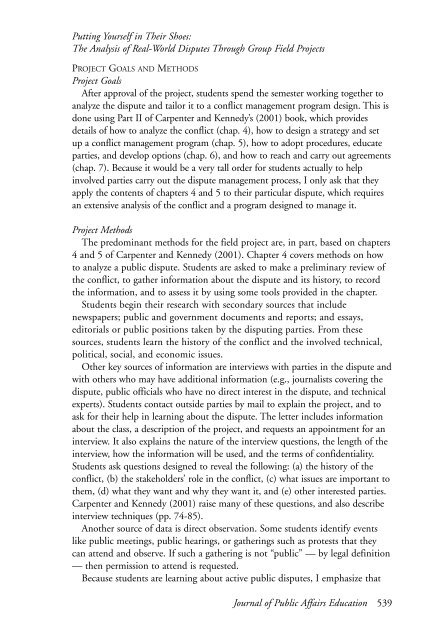JOURNAL OF PUBLIC AFFAIRS EDUCATION - National ...
JOURNAL OF PUBLIC AFFAIRS EDUCATION - National ...
JOURNAL OF PUBLIC AFFAIRS EDUCATION - National ...
Create successful ePaper yourself
Turn your PDF publications into a flip-book with our unique Google optimized e-Paper software.
Putting Yourself in Their Shoes:<br />
The Analysis of Real-World Disputes Through Group Field Projects<br />
PROJECT GOALS AND METHODS<br />
Project Goals<br />
After approval of the project, students spend the semester working together to<br />
analyze the dispute and tailor it to a conflict management program design. This is<br />
done using Part II of Carpenter and Kennedy’s (2001) book, which provides<br />
details of how to analyze the conflict (chap. 4), how to design a strategy and set<br />
up a conflict management program (chap. 5), how to adopt procedures, educate<br />
parties, and develop options (chap. 6), and how to reach and carry out agreements<br />
(chap. 7). Because it would be a very tall order for students actually to help<br />
involved parties carry out the dispute management process, I only ask that they<br />
apply the contents of chapters 4 and 5 to their particular dispute, which requires<br />
an extensive analysis of the conflict and a program designed to manage it.<br />
Project Methods<br />
The predominant methods for the field project are, in part, based on chapters<br />
4 and 5 of Carpenter and Kennedy (2001). Chapter 4 covers methods on how<br />
to analyze a public dispute. Students are asked to make a preliminary review of<br />
the conflict, to gather information about the dispute and its history, to record<br />
the information, and to assess it by using some tools provided in the chapter.<br />
Students begin their research with secondary sources that include<br />
newspapers; public and government documents and reports; and essays,<br />
editorials or public positions taken by the disputing parties. From these<br />
sources, students learn the history of the conflict and the involved technical,<br />
political, social, and economic issues.<br />
Other key sources of information are interviews with parties in the dispute and<br />
with others who may have additional information (e.g., journalists covering the<br />
dispute, public officials who have no direct interest in the dispute, and technical<br />
experts). Students contact outside parties by mail to explain the project, and to<br />
ask for their help in learning about the dispute. The letter includes information<br />
about the class, a description of the project, and requests an appointment for an<br />
interview. It also explains the nature of the interview questions, the length of the<br />
interview, how the information will be used, and the terms of confidentiality.<br />
Students ask questions designed to reveal the following: (a) the history of the<br />
conflict, (b) the stakeholders’ role in the conflict, (c) what issues are important to<br />
them, (d) what they want and why they want it, and (e) other interested parties.<br />
Carpenter and Kennedy (2001) raise many of these questions, and also describe<br />
interview techniques (pp. 74-85).<br />
Another source of data is direct observation. Some students identify events<br />
like public meetings, public hearings, or gatherings such as protests that they<br />
can attend and observe. If such a gathering is not “public” — by legal definition<br />
— then permission to attend is requested.<br />
Because students are learning about active public disputes, I emphasize that<br />
Journal of Public Affairs Education 539

















